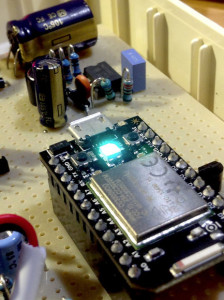This is a magic box which will let you monitor the power consumption of your house from anywhere on the Internet! It measures both true power (Watts) and apparent (VA) power, it keeps a running total of electricity units used, and measures mains frequency as a bonus.
The project uses a Particle Core(*) module – a little board with an ARM microprocessor and a Wi-Fi interface – to do all the hard work. To build it, you’ll need to be able to solder and follow a simple circuit diagram. At UK prices, total parts cost should be no more than £50.
The project was designed for 230V 50Hz (European) mains circuits, but with suitable calibration ought to work on US or other systems.
* – until a few days ago, Particle were known as Spark. You’ll find ‘Spark’ sprinkled throughout the supporting files for this project – please be assured these are the same thing!
You’ll need the following major components:
The Particle Core (a.k.a. Spark Core) module
This comes in a nice little kit with a breadboard and USB lead. You can buy one direct from Particle at https://store.particle.io/, from Adafruit, or in the UK the cheapest I’ve found is from CPC.
There are two versions of the Core – one with a built-in ‘chip’ antenna, and one with a u.FL socket for an external antenna. I’ve found the built-in antenna is fine anywhere in my house where there is normal (“two or three blobs on an iPod”) Wi-Fi reception. The external antenna would be better for poor signal areas (e.g. an outbuilding) but you’ll have to add the cost of a separate Wi-Fi antenna and a u.FL ‘pigtail’ lead.
AC Current Sensor
This is a small magnetic device which clamps over a current-carrying mains conductor, and produce an output voltage which is proportional to the current flowing in the wire. The one I used was for an Owl home energy monitor, but you can search Amazon, eBay, etc, for ‘AC Current Sensor’ for a variety of alternatives. Make sure you choose one with enough maximum current capability for the load you’re wanting to measure (e.g. 30A = 7kW approx). Please note – you don’t want to use a ‘current shunt’: these are not isolated from the mains itself and cannot be used in this design.
For More Details: Internet-connected home energy monitor

